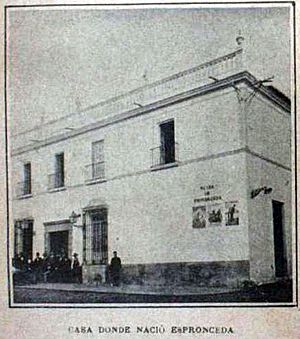José de Espronceda facts for kids
Quick facts for kids
José de Espronceda
|
|
|---|---|

El escritor José de Espronceda, portrait by Antonio María Esquivel (c.1845) (Museo del Prado, Madrid)
|
|
| Born |
José Ignacio Javier Oriol Encarnación de Espronceda y Delgado
25 March 1808 Almendralejo, Province of Badajoz, Extremadura, Spain
|
| Died | 23 May 1842 (aged 34) Madrid, Spain
|
| Resting place | Cementerio de San Justo |
| Nationality | Spanish |
| Occupation | Poet, writer and journalist |
| Movement | Romanticism |
| Children | Blanca Espronceda de Escosura (1834–1900) |
| Parent(s) |
|
José Ignacio Javier Oriol Encarnación de Espronceda y Delgado (born March 25, 1808 – died May 23, 1842) was an important Spanish poet. He lived during the 19th century and was a key figure in the Romantic movement. His poems and writings made him one of the most famous authors of his time. He was inspired by many writers, including Eugenio de Ochoa and Alfred, Lord Tennyson.
Life of José de Espronceda
José de Espronceda was born in Almendralejo, a town in Spain. When he was young, he studied in Madrid. His teacher, Alberto Lista, greatly influenced him.
At just 15 years old, José joined a secret group called "Los Numantinos". With his friends, he planned to go against the king, Ferdinand VII. Because of this, he was put in a monastery and then had to leave Spain.
He traveled and lived in many countries. These included Lisbon, Belgium, France, England, and Holland. When he returned to Spain in 1833, he became very involved in politics. He supported big changes in the government.
Espronceda is also known for his connection to Teresa Mancha. He wrote a famous poem for her called "Canto a Teresa." This poem is part of his larger work, El diablo mundo. José de Espronceda sadly passed away in 1842 from diphtheria, a serious illness. In 1902, his body was moved to the Panteón de Hombres Ilustres in Spain. This is a special place for famous people.
José de Espronceda's Literary Works
Espronceda's teacher, Alberto Lista, encouraged him to become a writer. While he was in the monastery, he started writing a long poem about history called El Pelayo. However, he never finished it.
He also wrote a novel titled Sancho Saldaña. Some of his other important works include El estudiante de Salamanca. The main character in this story is Don Félix de Montemar.
Other famous poems by Espronceda are El mendigo (The Beggar) and ¡Guerra! (War!). He also wrote Al dos de mayo and El diablo mundo. El diablo mundo is a very long lyric poem that he did not finish.
His other notable poems include A Jarifa en una orgía, El verdugo (The Executioner), El canto del cosaco (The Cossack's Song), La canción del pirata (The Pirate's Song), and Himno al sol (Hymn to the Sun). Many of his writings show the style of Romanticism. Along with José Zorrilla, Espronceda is seen as one of Spain's most important Romantic poets. He was also known for being very rebellious in his writing.
In 2006, Diego Martinez Torron published a special edition of all of Espronceda's works. This edition included some texts that had never been seen before. He also published new texts in a book called El otro Espronceda.
See also
 In Spanish: José de Espronceda para niños
In Spanish: José de Espronceda para niños


